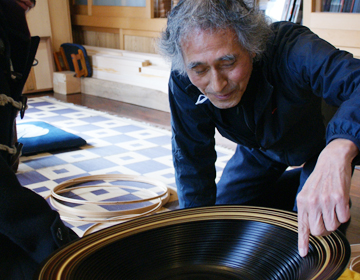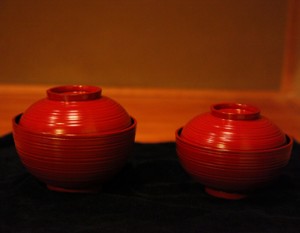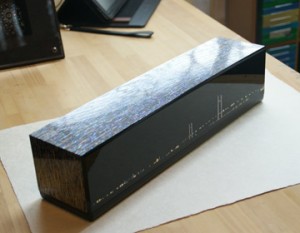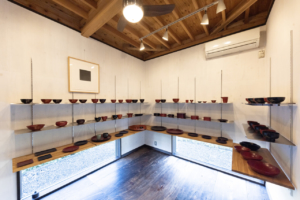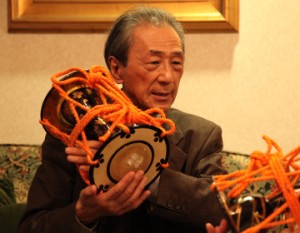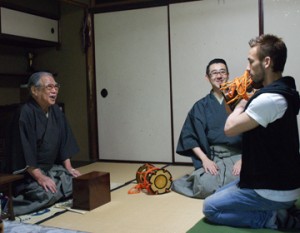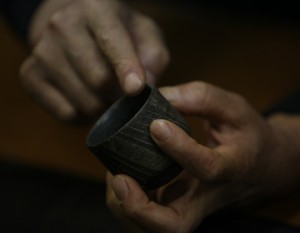I knew nothing about traditional crafts
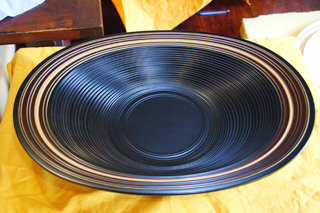
“Now please everyone relax and loosen your legs. Make yourselves comfortable. Interviewer, interviewee, we’re all equal. No bosses here”. Isao Ohnishi is accredited as the nation’s Important Intangible Cultural Property in the field of lacquer craft. However, he does not come from an old lacquer craft family.
In fact, he was born in a small coal mine town and skipped through a variety of jobs all over the nation when he was young. ”I knew nothing about traditional crafts. It was by coincidence I wound up this way. I don’t have much formal education either, but I thought a craftsman should somehow be able to make a living. It was something like that.. ” When he was living in Kanagawa, he learned about ”Kamakura Bori Sculpture”, and as he frequented the workshops, he came across lacquer crafting.
I love something that is edgy
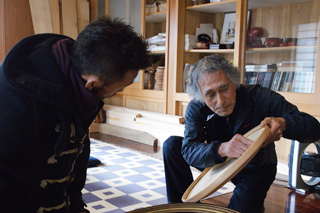
We looked at one of his works. It is a big platter.Careful observation revealed mutiple visible layers. ”This one was made from layers of boards. That is a no-no in this profession. The reason is because it takes too much time and effort. This involves slicing thin boards of ”Kiso Cypress”, then bending them in a round shape. Then you laquer each and every one of these boards and sand and polish them. Then layer all these to make a large platter. In lacquer crafting where repeated lauer application and polishing is a necessity, such work will require unthinkable patience. That’s what he meant when he said this is a no-no. ”I’ve always liked something really sharp and polished, like the blade of a samurai sword. You only have one life, so for me to live like myself, I would like to be making something that I want to make. I can’t be doing this if making money was my prime interest.
Strong lacquer

In the workshop, he showed us the raw material ”urushi”for lacquer. ”You know beehives? The stuff they use to stick the beehive on the tree is said to be ”urushi” lacquer. It has the function of adhesive when dry and it doesn’t rot. ” In the pail was some locally collected, thick ”urushi” lacquer. ”This is ”urame urushi”. It is the last ”urushi” that can be collected from an ”urushi” tree. It is a durable lacquer that can be used for fishing.” However durable means it takes strength to polish the surface. Mr.Ohnishi excels in a finishing skill called ”nuritate” where one finishes without polishing.. This method relies on instantaneous timing. ”Oh I am more of a risk taker. I like it when finish is decided in the particular moment.” he said.
You can do it if you try
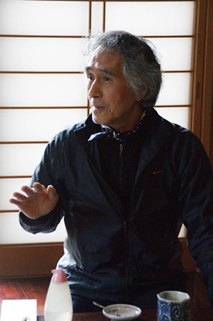
”What makes ”urushi” lacquer difficult?” Nakata asked. Onishi replied ”Difficult… Actually, there isn’t anything that difficult with this. Lacquer work is a matter of applying and shining. In other words, it’s addition and subtraction. Adjustments can be made. You just need to spend time doing it. You can it if you try. So, it’s really not that difficult.”
This may be true. It may just be easy to give up just because it seems difficult.
He also added, using his own style of euphemism. ”For instance with a marathon, some run to win, others to set some kind of record. It’s more interesting if you challenge things wanting to achieve something.” he laughed. During the interview, Onishi shared his thoughts about how to live and about his work throughout the interview. His pieces are a product of his philosophy that ”you can do it if you try”, combined with a lot of time and work all done by hand.



